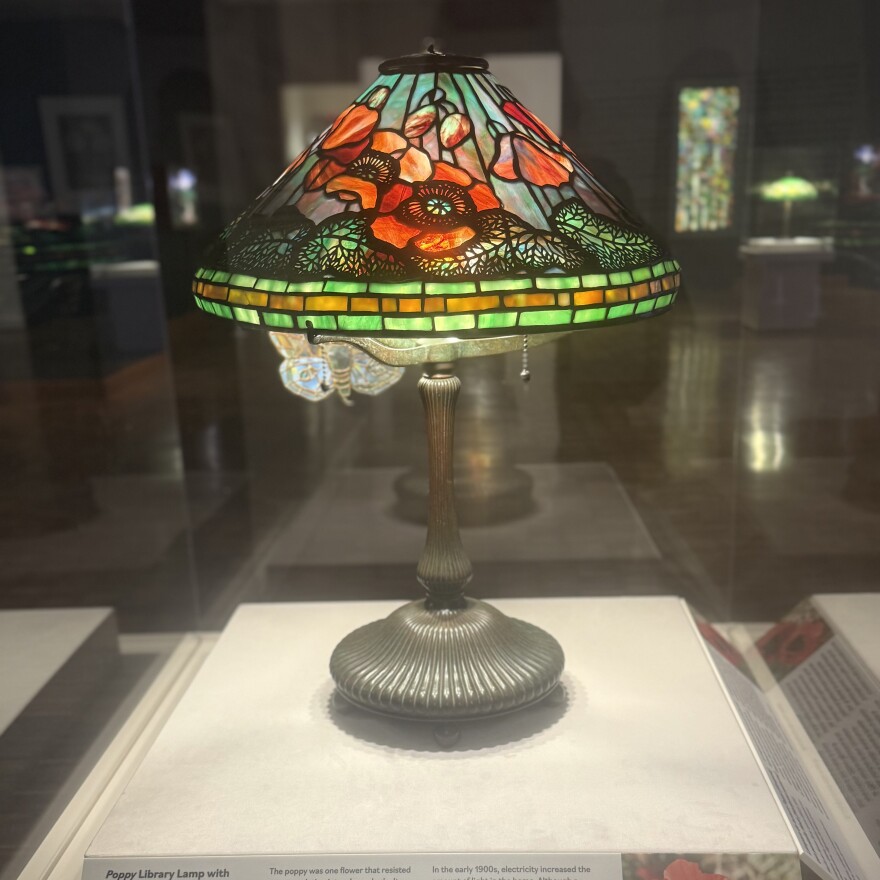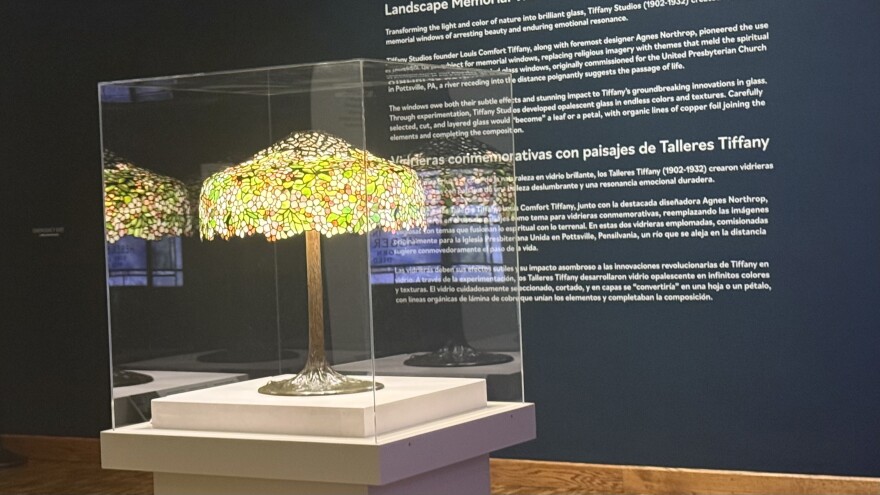ALLENTOWN, Pa. — Louis Comfort Tiffany famously said that God has given us our talents not to copy the talents of others, but rather to use our brains and imagination.
Surely it was that imagination Tiffany summoned, as evident in a pair of transcedent stained-glass memorial Tiffany windows now on display at the Allentown Art Museum.
Up close, the one-of-a-kind 14-foot windows — created by Tiffany and Agnes Northrup — are, as Tiffany himself once remarked, "a revelation of true beauty."
They are part of the museum's new "Summer of Tiffany" exhibition, which also features a collection of 10 Tiffany Studios' lamps, part of the "Tiffany’s Gardens in Glass."
The exhibit opens at 11 a.m. Saturday, April 26, and is open 11 a.m.-4 p.m. Thursday-Sunday and 11 a.m.-8 p.m. Thursdays.
It's free, is as the rest of the museum at 31 N. Fifth St., Allentown. Parking in the museum's Linden Street lot also is free.
"Tiffany Gardens in Glass" was curated and is on loan by the Neustadt Collection of Tiffany Glass, Queens, New York.
The lamps will be on display at the museum through June 29.

Tiffany lamps are considered a huge part of the Art Nouveau movement and are highly coveted by interior designers and collectors.
An authentic Tiffany lamp can cost $4,000 to $1 million.
A historical purchase
The memorial Tiffany windows originally were commissioned for United Presbyterian Church in Pottsville, Schuylkill County, and were memorialized for Heber S. Thompson (1840-1911), a church elder, and Sarah Ann Derr (1834-1918).
Back in the 1890s, it was common for wealthy members of the church to create memorial windows for their loved ones.
The Thompson window (1913) is accompanied by a biblical inscription, "Ho, every one that thirsteth, come ye to the waters."
The Derr window (1919) inscription reads: "He leadeth me beside the still waters, He restoreth my soul."
Both passages match the windows, which feature a landscape filled with a stream, tall trees, red and blue flowers, and a bedazzling sunset, which represents a person's journey to the afterlife.
The solace of nature
Typically, memorial windows were commissioned by families using biblical subjects and figural scenes such as angels.
Tiffany windows typically suggest the solace of nature, an idea pioneered by Tiffany and Northrop.
Northrop, known for her finely executed floral compositions, designed intricate amethyst irisies on the windows.
"These windows have four layers of glass, which helps get these effects of distance."Elaine Mehalikis, Vice President of Curatorial Affairs at the Allentown Art Museum
"Agnes Northrop would've made a watercolor drawing for these, and then they would create a full-scale cartoon," museum Vice President of Curatorial Affairs Elaine Mehalakes said.
"From there, they would select the pieces of glass that were going to represent each of the elements of nature."
Tiffany Studios closed in the 1930s. Its designers were known for their distinctive style and use of opalescent Favrile glass that transmits light and intensifies colors.
They also were known to experiment, as seen in the Thompson and Derr windows (look closely and you'll see hundreds of colors reflected in the layers).
"Other glass makers at the time making windows would have like one or maybe two layers of glass," Mehalakes said. "These windows have four layers of glass, which helps get these effects of distance."
Because of the multi-layers, Tiffany and Northrop had an understanding of how the colors were going to work when the sunlight hit.
"They used techniques like streaky glass, so for the sky and the water, where they were mixing different kinds of colors of glass," Mehalakes said.
"That was difficult because the glass doesn't always like to play nicely, depending on what its composition is.
"Both in terms of the technical aspects as well a the ground-breaking subject matter, these windows are special and also quite rare, and they don't become available very often."

Special LED illumination
In their original setting, the windows were transformed by the weather and time of day.
Now, in the museum, the windows are presented with a periodically changing light program to let visitors see the color changes.
Steve Gamler, lead preparator at the museum, spearheaded the construction of the LED light emitters that can be controlled independently for color, temperature and intensity.
"... It'll play at the top of the hour and on the half hour, so people can kind of plan their time to be in the space if they want to experience that."Steve Gamler, lead preparator at the museum
They are pre-programmed to dim the room and intimately darken the windows, then they slowly turn back on to reveal the brilliance of Tiffany and Northrop's orange and yellow sunset designs.
"The normal cycle is closer to two minutes down," Gamler said. "Two minutes up, and it'll play at the top of the hour and on the half hour, so people can kind of plan their time to be in the space if they want to experience that."
While it is common for museums to incorporate LED lighting, known to reduce the risk of fading and material degradation, it is a first for the Tiffany windows.
"We did a lot of research throughout the project and talked with other museums and generally, what they do is they have a flat LED light pad that kind of goes directly behind the glass," Mehalakes said.
"So they're not able to have the control and to create these color changes that we are."
Donor support
The price for the installation of the Tiffany windows was $1.5 million, the museum's most expensive purchase.
It was funded by more than 220 donors.
"Every time I see these, it's a breathtaking feeling, a physical feeling. And so that's incredibly rare and unusual."Elaine Mehalikis, Vice President of Curatorial Affairs at the Allentown Art Museum
"So many people have been involved, some of whom have donated in memory of lost loved ones, which is so perfect in keeping with the windows themselves and sort of what they were originally meant to offer," Mehalakes said.
"Which is a place for contemplation for these profound issues that we deal with as human beings in our lives.
"Every time I see these, it's a breathtaking feeling, a physical feeling. And so that's incredibly rare and unusual. It's a major milestone for us and something that will define the institution."
To celebrate the arrival of the windows in their new home, the museum will offer a full schedule of English and Spanish programs related to Tiffany.
For more information, go to the Allentown Art Museum's website.


